6 Natural Wonders of the World to Explore in 2025
Discover 6 incredible natural wonders of the world. Explore the geology, history, and travel tips for these breathtaking locations in our 2025 guide.
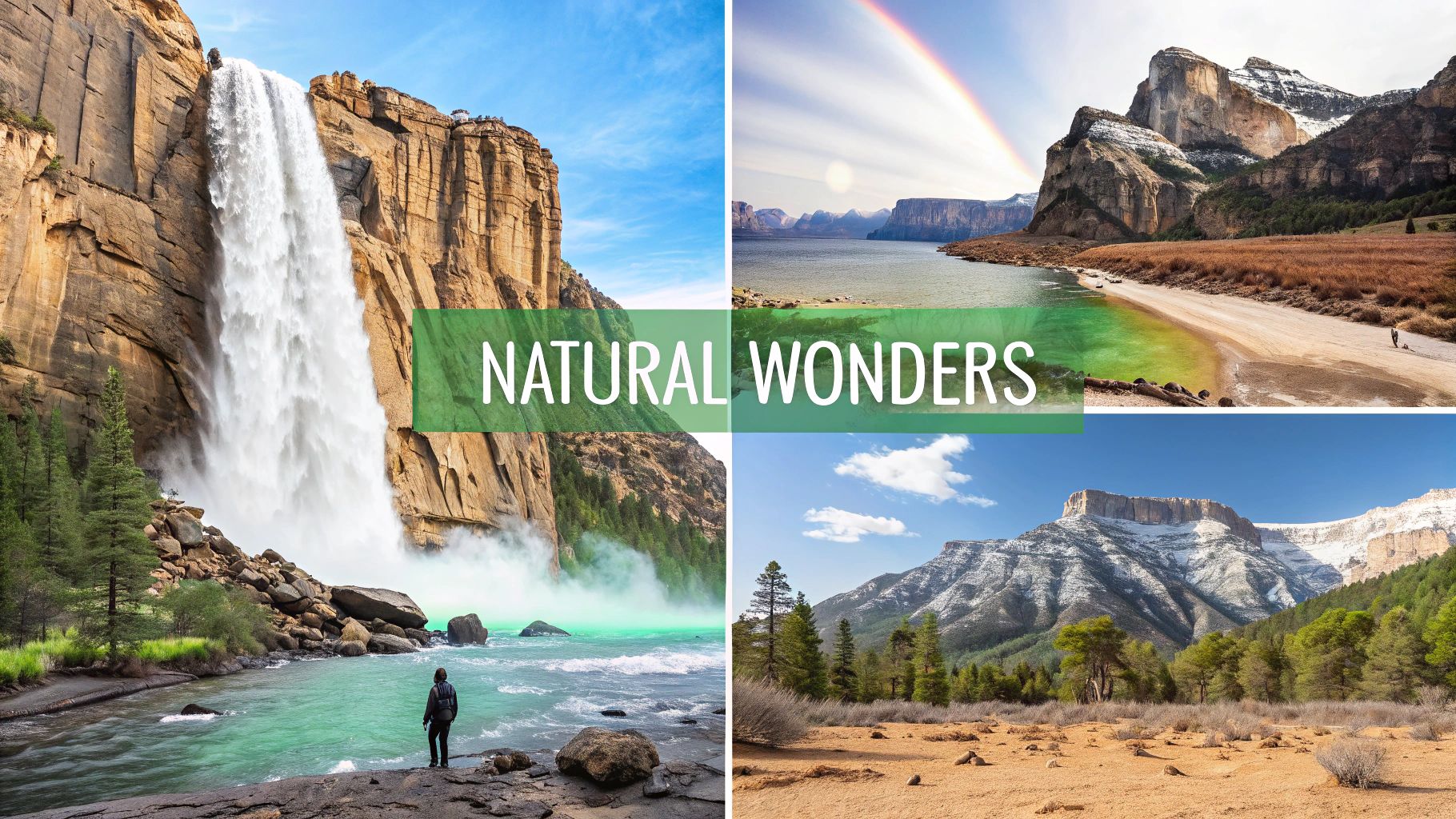
The Earth is a canvas of breathtaking artistry, painted with colossal canyons, ethereal light shows, and towering peaks that defy imagination. These are the natural wonders of the world, sites of immense power, beauty, and scientific importance that have captivated humanity for millennia. They are far more than just picturesque destinations; they are living museums and dynamic chapters in our planet's epic story, revealing billions of years of geological drama, ecological evolution, and the relentless forces that continue to shape our world. Understanding these spectacles offers a profound connection to the planet's history and its intricate systems.
This guide is designed as a comprehensive expedition into six of these legendary locations, from the vibrant underwater cities of the Great Barrier Reef to the volcanic fury of Parícutin. We will journey beyond the postcard images to explore the fascinating geology that carved these landscapes and the unique ecosystems that thrive within them. Each entry provides a deep dive into the cultural significance these wonders hold for local communities and offers practical, actionable tips to help you plan your own visit.
For geography enthusiasts and gamers, we’ve included a unique twist. Alongside each profile, you will find a custom in-game challenge inspired by the popular geography game EarthChasers. These missions are crafted to test your knowledge and strategic thinking, allowing you to engage with these incredible sites in a new, interactive way. Prepare to be inspired by the raw, untamed beauty of our world and embark on an adventure that spans both the physical and digital realms. This list is your gateway to appreciating the planet's greatest masterpieces.
1. Aurora Borealis (Northern Lights)
The Aurora Borealis, or Northern Lights, is an ethereal, celestial ballet that has captivated humanity for millennia. This breathtaking light show is not just beautiful; it's a direct visual representation of the powerful connection between the Sun and Earth. It occurs when highly energetic, electrically charged particles from solar winds are funneled by Earth's magnetic field toward the polar regions. Upon entering our upper atmosphere, these particles collide with gas atoms like oxygen and nitrogen, releasing energy in the form of photons, which we perceive as curtains of vibrant, dancing light. This phenomenon rightfully earns its place as one of the most dynamic and awe-inspiring natural wonders of the world.
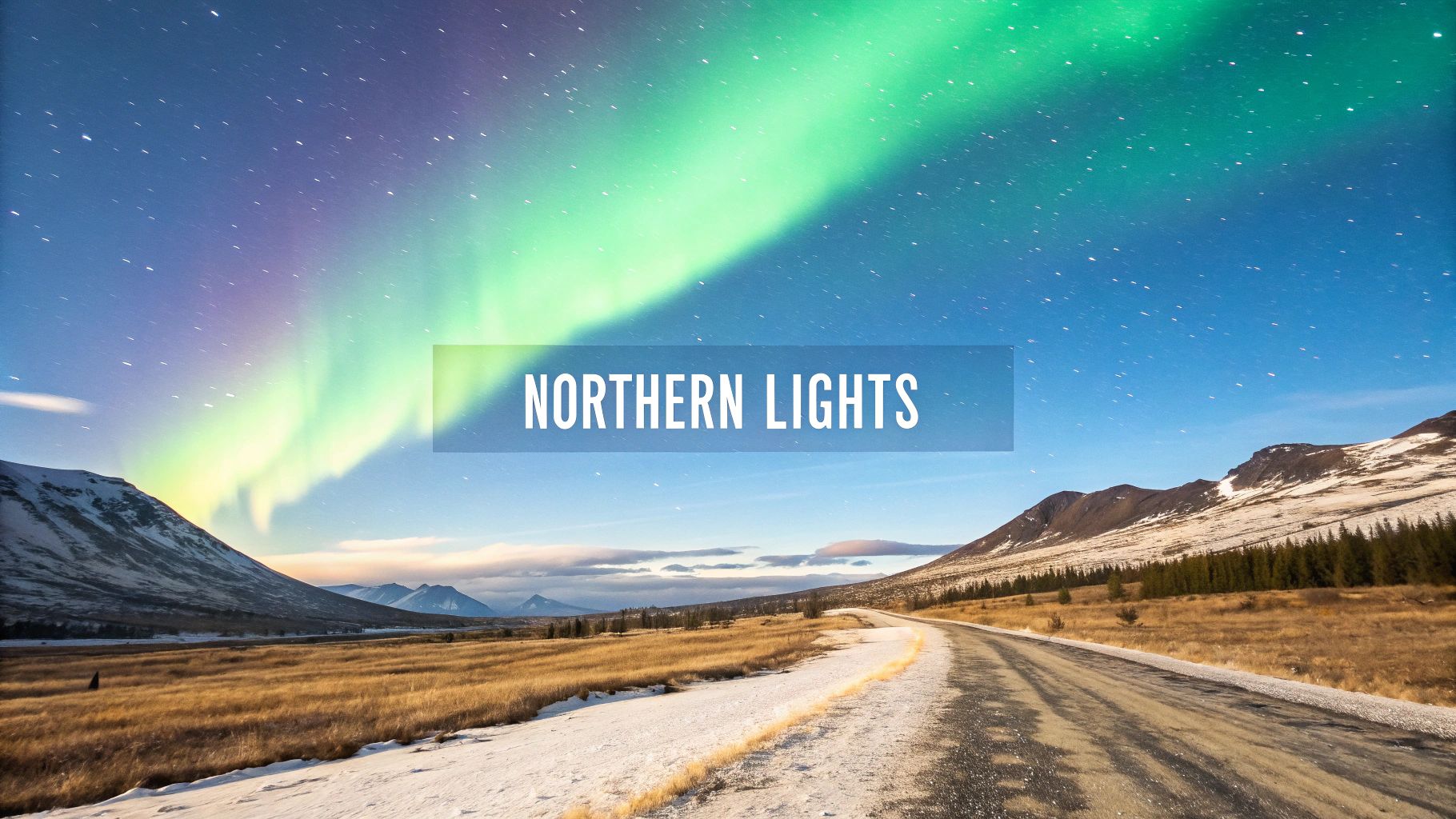
The colors of the aurora depend on which gas is being excited and at what altitude. The most common color, a brilliant green, is produced by oxygen molecules at about 60 to 150 miles high. Rarer, all-red auroras are created by high-altitude oxygen (above 150 miles), while pink and dark red hues appear at lower altitudes. Blue and purple lights are often generated by nitrogen molecules.
Prime Viewing Destinations
While the aurora can technically be seen anywhere within the auroral oval, certain locations offer consistently better viewing opportunities due to clear skies, minimal light pollution, and prime geographical positioning.
- Tromsø, Norway: Often called the "Paris of the North," Tromsø sits directly under the auroral oval, making it a premier destination for chasers. Its coastal location often provides clearer skies than inland areas.
- Yellowknife, Canada: This city boasts an incredible viewing rate, with the aurora visible on average for more than 240 nights per year. Its flat landscape and distance from large bodies of water contribute to exceptionally clear, stable weather.
- Fairbanks, Alaska, USA: Located in the auroral interior, Fairbanks offers a fantastic balance of accessibility and prime viewing conditions, far from the light pollution of major urban centers.
- Iceland's Golden Circle: Viewing the Northern Lights in Iceland allows you to combine the celestial display with other geological marvels like geysers, waterfalls, and volcanic landscapes, creating an unforgettable experience.
Practical Tips for Aurora Chasers
Witnessing this natural wonder often requires patience and preparation. Maximize your chances with these actionable tips:
- Check the Forecast: Use apps and websites like the Space Weather Prediction Center to monitor the KP index, a scale from 0 to 9 that measures geomagnetic activity. A KP of 4 or higher indicates a good chance of a strong display.
- Timing is Everything: The best viewing months are typically from September to April. For the darkest skies, plan your trip around the new moon phase to avoid moonlight washing out the display.
- Dress for Success: You will be outside in the cold for extended periods. Dress in multiple, insulated layers, including thermal underwear, fleece, a windproof outer shell, warm boots, gloves, and a hat.
- Master Your Camera: To capture the lights, you'll need a camera with manual settings. Use a tripod, a wide-angle lens with a low aperture (e.g., f/2.8), and experiment with long exposure times (5-20 seconds) and a high ISO (800-3200).
In-Game Challenge: The Celestial Cartographer Quest
For our gamer readers, imagine a challenge in an open-world RPG. Your quest is to locate and "attune" to three ancient monoliths scattered across a vast, frozen tundra. Each monolith only becomes active under a powerful aurora (requiring you to track the in-game celestial forecast). Activating all three before dawn unlocks a rare cosmic ability or a map to a hidden, celestial-themed dungeon, turning this natural wonder into a dynamic and rewarding game mechanic.
2. Grand Canyon
The Grand Canyon is a colossal chasm carved by the relentless power of the Colorado River over millions of years. This geological masterpiece in Arizona, USA, is a breathtaking testament to the forces of erosion, stretching 277 miles long, up to 18 miles wide, and plunging more than a mile deep. Its beautifully layered walls of rock reveal nearly two billion years of Earth's geological history, a vibrant timeline painted in shades of red, orange, and purple. The sheer scale and ancient grandeur of the Grand Canyon firmly establish it as one of the most profound and visually stunning natural wonders of the world.
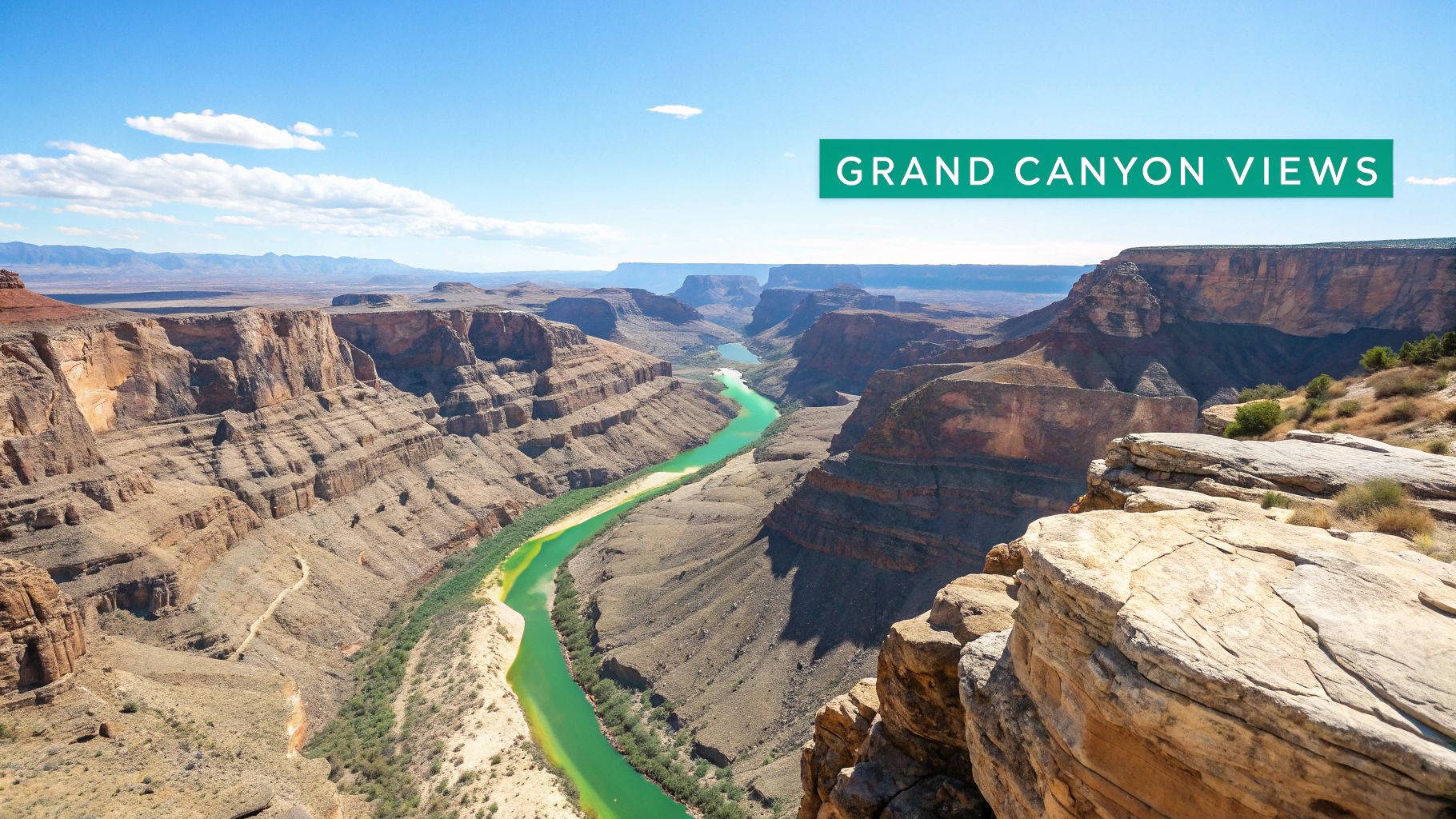
Each layer of rock in the canyon walls tells a different story of ancient environments, from primordial seas to vast deserts. The oldest rocks at the bottom, the Vishnu Schist, are about 1.8 billion years old, while the Kaibab Limestone at the rim is a relatively young 270 million years old. This incredible geological cross-section, famously explored by John Wesley Powell in 1869 and championed for preservation by President Theodore Roosevelt, offers an unparalleled window into our planet's past. For those wanting to delve deeper, you can find more amazing geography facts on earthchasers.com.
Prime Exploration Destinations
While the entire canyon is magnificent, different areas offer unique perspectives and experiences, catering to all levels of adventurers.
- South Rim: The most popular and accessible section, the South Rim is open year-round and offers numerous iconic viewpoints, visitor centers, and well-maintained hiking trails. It's the classic Grand Canyon experience, ideal for first-time visitors.
- North Rim: Higher in elevation and more remote, the North Rim is less crowded and offers a different, wilder perspective. Open only from mid-May to mid-October, it provides cooler temperatures and a more serene atmosphere.
- Havasu Falls: This hidden oasis, located within the Havasupai Indian Reservation, is famous for its surreal turquoise waterfalls cascading into travertine pools. Access requires a difficult-to-obtain permit and a strenuous 10-mile hike each way.
- Colorado River Rafting: For the ultimate immersion, a multi-day rafting trip through the canyon floor provides a unique bottom-up view of the towering cliffs and a thrilling way to experience the canyon's raw power.
Practical Tips for Canyon Explorers
Visiting this immense landscape requires careful planning to ensure a safe and memorable trip. Maximize your experience with these essential tips:
- Check the Season: The shoulder seasons (April-May and September-October) offer the best balance of pleasant weather and smaller crowds. Summer brings extreme heat, especially within the inner canyon.
- Hike Smart: Always start hikes early in the morning to avoid the brutal afternoon sun. Remember that hiking down is optional, but hiking back up is mandatory and much more strenuous.
- Hydration is Key: Bring more water than you think you will need, especially if you plan to hike. Dehydration is a serious and common risk. Salty snacks are also crucial to replenish electrolytes.
- Book in Advance: Accommodations at the rims and permits for backcountry hiking or Havasu Falls are in high demand. Plan and book your trip many months, or even a year, ahead of time.
In-Game Challenge: The Canyon Cartographer Quest
Picture an adventure game quest where you must map the forgotten "Path of the Ancients" through a vast canyon. The quest involves deciphering petroglyphs at sunrise (when the light hits just right), navigating treacherous cliffside paths using limited climbing gear, and collecting rare geological samples from different rock strata. Completing the map before a seasonal flash flood makes the lower levels impassable rewards you with a legendary geological hammer or unlocks a special "Earthshaper" skill tree.
3. Great Barrier Reef
The Great Barrier Reef is a living masterpiece, so vast it can be seen from outer space. Stretching over 2,300 kilometers along the northeast coast of Australia, it is the world's largest single structure made by living organisms. This colossal ecosystem is not a single reef but a complex tapestry of over 2,900 individual reefs and 900 islands. Its sheer scale and staggering biodiversity, supporting a kaleidoscope of marine life, firmly establish it as one of the most vital and breathtaking natural wonders of the world. It stands as a powerful testament to the intricate beauty and delicate balance of life in our oceans.
The following bar chart visualizes the immense scale and biodiversity of the Great Barrier Reef by highlighting three key statistics.
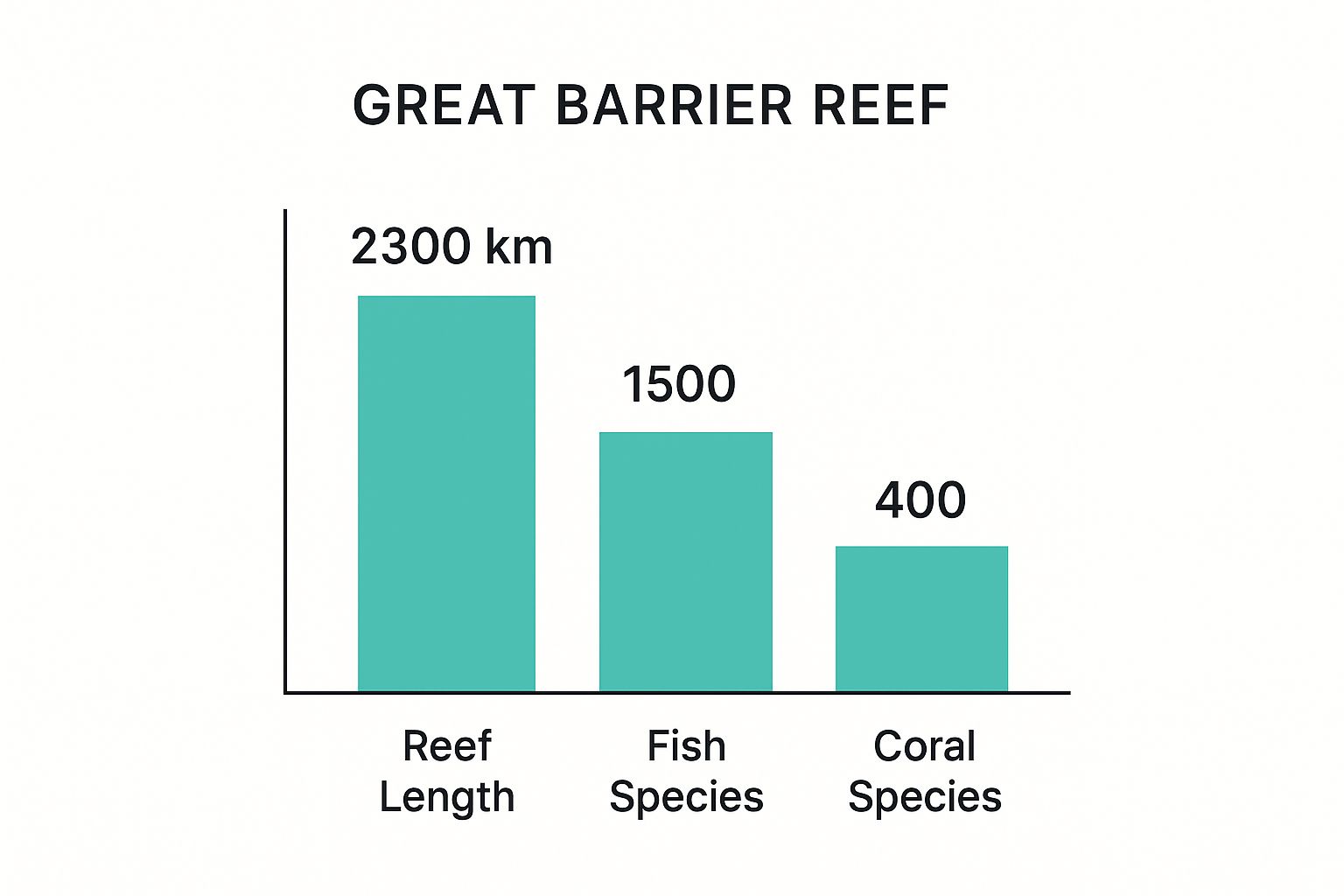
This data underscores the reef's status as a global hub of marine life, with a richness that is nearly unparalleled anywhere else on Earth. The reef is not just a collection of coral; it's a bustling underwater metropolis that supports thousands of species, from microscopic plankton to majestic humpback whales. The vibrant colors of the reef come from the symbiotic algae living within the coral polyps, creating a visually stunning environment that is crucial for the health of our planet's oceans. To dive deeper into the world's marine ecosystems, you can explore more about the oceans and seas of the world on earthchasers.com.
Prime Exploration Hubs
Accessing this underwater marvel is surprisingly straightforward, with several key locations serving as gateways to different reef experiences, each offering a unique perspective on this vast ecosystem.
- Cairns, Queensland: Known as the primary gateway to the reef, Cairns offers a wide array of tours, from day trips for snorkeling to multi-day diving expeditions, catering to all experience levels.
- The Whitsunday Islands: This stunning archipelago of 74 islands provides access to some of the most pristine and protected sections of the reef, famous for their white-sand beaches and turquoise waters.
- Lady Elliot Island: A coral cay located at the southern tip of the reef, this eco-resort is a haven for marine life, including manta rays and sea turtles, offering an immersive conservation-focused experience.
- Heron Island: Situated directly on the reef, this island is renowned for its world-class diving and is home to a university research station, making it a hotspot for both tourism and science.
Practical Tips for Reef Visitors
To ensure your visit is both memorable and responsible, a little planning goes a long way. These tips will help you experience the reef's magic while helping to preserve it.
- Be Sun-Smart and Reef-Safe: The Australian sun is intense. Use high-SPF, broad-spectrum sunscreen that is "reef-safe" (free of oxybenzone and octinoxate) to protect both your skin and the delicate coral.
- Choose Eco-Certified Operators: Look for tour companies with advanced ecotourism certifications. These operators adhere to strict environmental standards, minimizing their impact and often contributing to conservation efforts.
- Timing is Key: The dry season, from June to October, typically offers the best water clarity and weather conditions. This period also coincides with the migration of dwarf minke and humpback whales.
- Go Remote with a Live-Aboard: For serious divers and snorkelers, a live-aboard boat provides access to the less-visited outer reefs, where marine biodiversity is at its most spectacular and untouched.
In-Game Challenge: The Coral Heart Quest
Picture a mission in a survival-crafting game set on a chain of tropical islands. You must craft a special submersible to explore a sprawling underwater reef biome. Your objective is to find and collect bioluminescent samples from three rare, deep-water coral species without damaging the surrounding ecosystem. These samples are needed to synthesize an antidote for a spreading blight. This quest would blend exploration, crafting, and environmental awareness, making the vibrant digital reef a central and interactive part of the game's narrative.
4. Mount Everest
Standing as the colossal rooftop of the world, Mount Everest is Earth's highest mountain above sea level, reaching a staggering 8,848.86 meters (29,031.7 feet). Located in the majestic Mahalangur Himal sub-range of the Himalayas, this iconic peak straddles the border between Nepal and the Tibet Autonomous Region of China. Known as Sagarmatha ("Forehead in the Sky") in Nepali and Chomolungma ("Holy Mother") in Tibetan, Everest is more than a mountain; it is a testament to the raw power of plate tectonics and a symbol of ultimate human ambition and endurance. Its formidable presence and the extreme challenge it poses to climbers have solidified its place among the most revered natural wonders of the world.
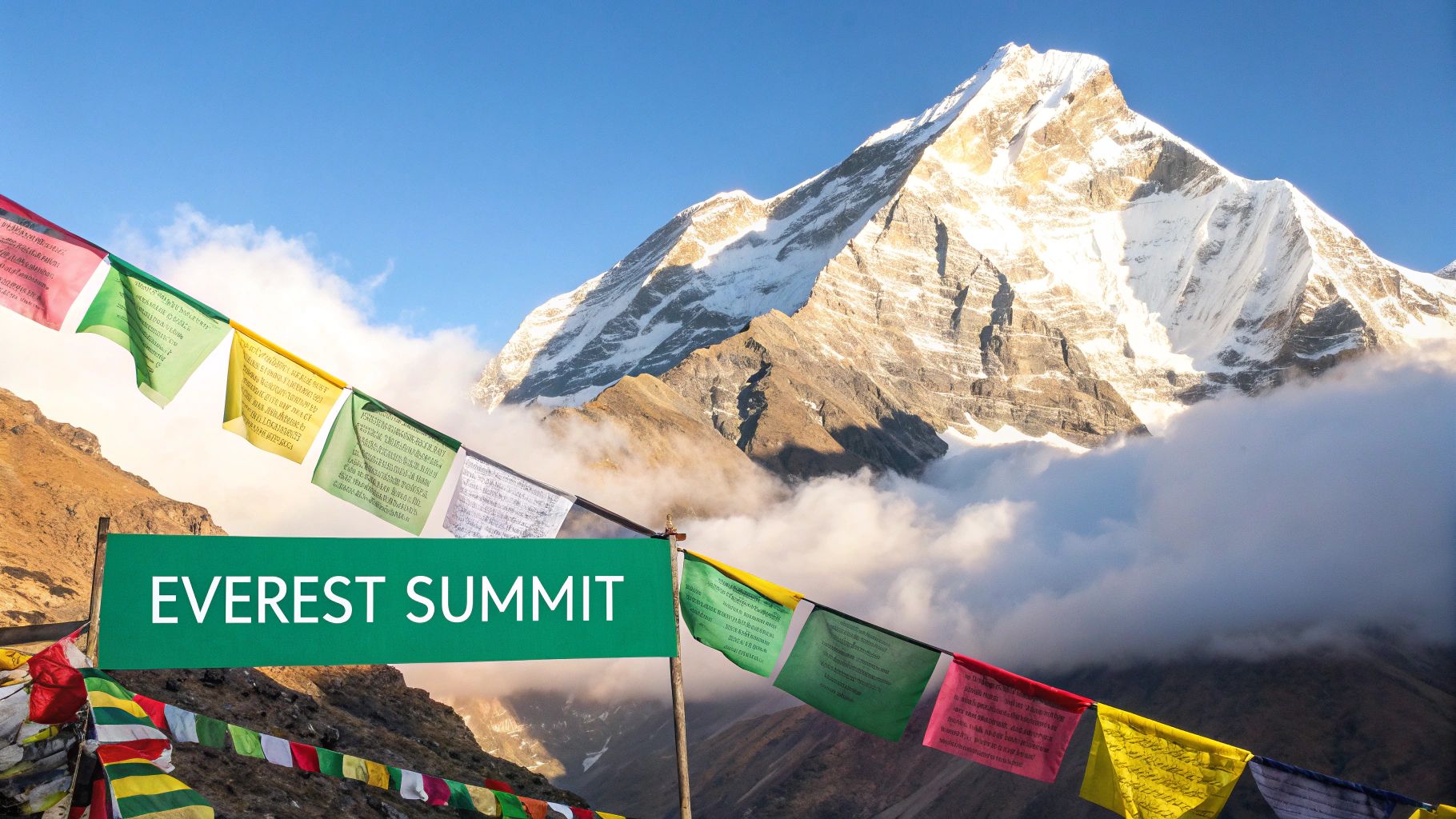
This immense geological formation is the result of the Indian-Australian Plate colliding with the Eurasian Plate, a process that began some 50 million years ago and continues to push the Himalayas upward by several millimeters each year. The mountain's summit is a harsh environment of perennial ice, hurricane-force winds, and dangerously low oxygen levels, making it one of the most inhospitable places on Earth. The first confirmed successful ascent by Sir Edmund Hillary and Tenzing Norgay in 1953 transformed mountaineering forever, turning this remote peak into a global icon of exploration and achievement.
Prime Routes and Experiences
While a summit attempt is reserved for elite mountaineers, there are various ways to experience the grandeur of Everest, catering to different levels of fitness and ambition.
- South Col Route (Nepal): This is the most popular and commercially guided route to the summit, famously used by Hillary and Norgay. The journey begins with the trek to Everest Base Camp, a world-renowned adventure in its own right.
- North Col Route (Tibet): A technically more challenging and less crowded alternative, the North Ridge route offers a different perspective and historical significance, as it was the path of early British attempts in the 1920s.
- Everest Base Camp Trek: Accessible to fit non-climbers, this two-week trek through the Khumbu Valley is an incredible journey through Sherpa culture and stunning Himalayan landscapes, culminating at the foot of the world's tallest mountain.
- Advanced Base Camp: From the Tibetan side, it is possible to travel by vehicle and a short trek to reach Advanced Base Camp (ABC) at around 6,400 meters, offering breathtaking close-up views of the North Face.
Practical Tips for Aspiring Adventurers
Approaching Everest in any capacity requires immense respect for its power and thorough preparation. Understanding the elevation of Mount Everest is critical and you can explore detailed elevation data on earthchasers.com.
- Undergo Rigorous Training: A summit attempt requires years of dedicated physical and mental preparation, including high-altitude mountaineering experience. Even the Base Camp trek demands a high level of cardiovascular fitness.
- Acclimatize Properly: Altitude sickness is a serious and potentially fatal risk. All itineraries must include gradual ascent profiles with built-in rest days to allow the body to adapt to the thin air.
- Hire Reputable Operators: Your safety is paramount. Thoroughly vet expedition companies and hire experienced, certified Sherpa guides who understand the mountain's dangers and weather patterns.
- Embrace "Leave No Trace": The fragile ecosystem of Everest is under strain. Pack out everything you bring in, respect local customs, and support sustainable tourism practices to preserve this wonder for future generations.
In-Game Challenge: The Summit of the Ancients Raid
Imagine a massive multiplayer online raid where the final boss is a colossal, frost-breathing titan slumbering atop a mountain modeled after Everest. The raid party must battle through treacherous icefalls, survive environmental hazards like avalanches and blizzards (requiring special gear), and manage an "acclimatization" debuff that weakens them at higher altitudes. Reaching the summit and defeating the titan before the "Death Zone" timer depletes your party's health would reward players with legendary ice-themed armor and the ultimate server-first achievement.
5. Victoria Falls
Known locally as Mosi-oa-Tunya, or "The Smoke That Thunders," Victoria Falls is a colossal curtain of water that commands respect and inspires awe. This UNESCO World Heritage site is not the world's highest or widest waterfall, but its combined height of 108 meters (354 feet) and width of 1,708 meters (5,604 feet) create the largest single sheet of falling water on the planet. The Zambezi River plunges into a transverse chasm, generating a thunderous roar and a towering plume of mist that can be seen from up to 50 kilometers away. Its sheer power and scale firmly establish Victoria Falls as one of the most magnificent natural wonders of the world.
The falls are located on the border between Zambia and Zimbabwe, offering distinct yet equally stunning perspectives from each country. The force of the water has carved out a series of zigzagging gorges, showcasing millions of years of geological history. This dramatic landscape, combined with the constant spray, supports a unique miniature rainforest ecosystem on the cliff faces, rich with lush vegetation that thrives in the perpetual moisture.
Prime Viewing and Activity Hubs
Experiencing Victoria Falls involves more than just observation; it's a hub for adventure and exploration, with each side of the border offering unique opportunities.
- Livingstone, Zambia: Known as the adventure capital of the region, Livingstone provides access to thrilling activities. It's the gateway to microlight flights over the falls and the famed Devil's Pool, a natural rock pool at the very edge of the precipice.
- Victoria Falls Town, Zimbabwe: This side is renowned for its panoramic views, with viewpoints covering about two-thirds of the falls' width. It offers a range of luxury accommodations and easy access to the main waterfalls within the Victoria Falls National Park.
- Devil's Pool: Accessible from the Zambian side during the low-water season (typically August to January), this natural infinity pool allows brave swimmers to peer directly over the edge of the falls.
- Zambezi River Cruises: Both upstream and downstream cruises are popular for experiencing the river's serene beauty. Sunset cruises offer spectacular views and opportunities to spot wildlife like hippos, crocodiles, and elephants along the riverbanks.
Practical Tips for Visitors
A trip to this mighty waterfall is an unforgettable experience, and a little planning can make it even better.
- Choose Your Season: The wet season (February to May) showcases the falls at their most powerful, but the immense spray can obscure views. The dry season (August to December) offers clearer vistas and is the only time to access Devil's Pool.
- Prepare to Get Wet: The mist, especially on the Zimbabwean side, is intense enough to feel like a heavy downpour. Bring waterproof clothing, a rain jacket, and protection for your camera and phone.
- Experience Both Sides: If time and visas permit, visit both the Zambian and Zimbabwean sides. They offer completely different perspectives and experiences of the falls' grandeur.
- Book Activities in Advance: Popular activities like Devil's Pool and helicopter tours have limited availability and should be booked well ahead of your trip, particularly during peak season.
In-Game Challenge: The River Serpent's Trial Quest
Imagine a quest in an action-adventure game where you must retrieve a sacred artifact from a hidden chamber behind the falls. To access it, you must first navigate a treacherous river section upstream, avoiding colossal crocodiles and territorial hippos. You then have to complete a timed, high-stakes platforming sequence across slippery, mist-covered rocks at the very edge of the waterfall (à la Devil's Pool) to find the entrance. Failure means being swept over the edge, forcing a restart from the last checkpoint and turning this natural wonder into a thrilling test of skill.
6. Parícutin Volcano
Parícutin Volcano offers a unique and dramatic story among the natural wonders of the world, as it is one of the very few volcanoes whose entire life cycle, from birth to dormancy, was witnessed and documented by modern science. Its sudden emergence in a Mexican cornfield in 1943 provides an unprecedented, real-time chronicle of geological creation. This is not a mountain that has stood for millennia, but a dynamic force that erupted into existence before human eyes, growing from a crack in the earth to a 424-meter cinder cone in less than a decade. The story of farmer Dionisio Pulido, who first saw the ground swell and fissure open, adds a powerful human element to its geological significance, cementing its status as a truly modern wonder.
The eruption, which lasted from 1943 to 1952, provided invaluable data for volcanologists, forever changing our understanding of cinder cone formation and volcanic behavior. The lava flows eventually buried two villages, but remarkably, no one was killed directly by the eruption. The most poignant remnant of this event is the half-buried bell tower of the San Juan Parangaricutiro church, which juts defiantly from a sea of solidified black lava, a stark monument to the immense power of nature.
Exploring the Volcanic Landscape
Visiting Parícutin is an adventure that combines geology, history, and culture. The stark, alien-like landscape of the lava fields provides a challenging but rewarding experience for hikers and explorers.
- San Juan Parangaricutiro: The ruins of this church are the most famous landmark. Reaching the site involves a trek across jagged, uneven lava rock, offering a visceral sense of the destruction and creation that took place here.
- Angahuan: This Purépecha indigenous village was spared by the lava flows and now serves as the primary base for tours to the volcano and the buried church. It offers an authentic cultural experience and a gateway to the region's history.
- Summit Hike: Adventurous travelers can hike or ride a horse to the summit of the cinder cone. From the top, you can peer into the dormant crater and enjoy panoramic views of the vast lava fields and the surrounding Michoacán landscape.
Practical Tips for Visitors
A trip to Parícutin requires preparation, as the terrain is rugged and the area is relatively remote. Plan your visit with these essential tips:
- Hire a Local Guide: The Purépecha guides from Angahuan offer invaluable expertise. They not only navigate the challenging terrain safely but also share generations of local history and cultural stories connected to the volcano.
- Wear Sturdy Footwear: The volcanic rock is sharp, uneven, and unforgiving. Durable, closed-toe hiking boots with strong ankle support are absolutely mandatory for safety and comfort.
- Prepare for the Elements: The high-altitude sun is intense, and there is little shade on the lava fields. Bring ample water, sunscreen, a wide-brimmed hat, and sunglasses to protect yourself.
- Best Time to Visit: The dry season, from November to April, offers the most pleasant weather conditions for hiking, with clearer skies and less chance of rain making the rocky paths slippery.
In-Game Challenge: The Heart of the Mountain Quest
Picture an in-game quest where a new volcanic island rapidly emerges from the sea. Your mission is to be the first to chart it and retrieve a rare "Primordial Heartstone" from its still-warm crater. You must navigate treacherous, shifting lava fields, vent toxic gas pockets, and race against rival factions. Successfully reaching the summit and claiming the artifact before the volcano stabilizes grants you a powerful fire-based crafting ability or unlocks a unique, elemental mount born from the eruption itself.
Natural Wonders Comparative Overview
| Item | Implementation Complexity 🔄 | Resource Requirements ⚡ | Expected Outcomes 📊 | Ideal Use Cases 💡 | Key Advantages ⭐ |
|---|---|---|---|---|---|
| Aurora Borealis | Low - natural phenomenon, no setup needed | Minimal - travel and warm clothing | Stunning natural light displays, eco-tourism boost | Northern high-latitude outdoor sightseeing | Free, transformative experience, great photos |
| Grand Canyon | Moderate - infrastructure and trail maintenance | Moderate - park services and visitor support | Geological insights, diverse recreational options | Hiking, geology education, tourism year-round | Easy access, educational, varied activities |
| Great Barrier Reef | High - conservation and ecological management | High - marine protection and tourism facilities | Rich marine biodiversity, tourism income | Diving, snorkeling, marine research | Largest coral system, biodiversity hotspot |
| Mount Everest | Very High - extreme climbing logistics and safety | Very High - expensive expeditions, guides | Ultimate mountaineering challenge, scientific data | High-altitude mountaineering and extreme adventure | Iconic, culturally significant, scientific value |
| Victoria Falls | Moderate - tourism infrastructure and safety | Moderate - facilities and adventure setup | Dramatic waterfall views, adventure tourism | Sightseeing, adventure sports, wildlife viewing | Easily accessible, adventure activities |
| Parícutin Volcano | Moderate - hiking access and guided tours | Low to Moderate - local guides and trails | Volcanic formation study, unique geological insights | Volcanology education, hiking, cultural experiences | Fully documented eruption, scientific significance |
Your Adventure Awaits: Explore the World Virtually and in Reality
Our journey across the globe has taken us from the celestial ballet of the Aurora Borealis to the raw, untamed power of Parícutin Volcano. We have descended into the geological masterpiece of the Grand Canyon, explored the vibrant underwater cities of the Great Barrier Reef, stood in the shadow of Mount Everest’s colossal peak, and felt the thunderous roar of Victoria Falls. Each of these natural wonders of the world is more than just a destination; it is a living classroom, a testament to the immense forces that have sculpted our planet over millennia.
By exploring their formation, cultural significance, and the delicate ecosystems they support, we gain a profound appreciation for Earth’s intricate systems. We learn that a wonder like the Great Barrier Reef is not merely a beautiful collection of coral but a fragile bastion of biodiversity facing existential threats. Similarly, understanding the plate tectonics that thrust Mount Everest skyward provides a deeper context than simply knowing it is the world’s highest peak. This article aimed to equip you not just with facts, but with a framework for seeing these places through the eyes of a geologist, a cultural historian, and an ecologist.
Key Takeaways from Our Global Expedition
Reflecting on these six incredible sites, several key themes emerge that can transform how we approach both travel and learning. These insights are designed to be actionable, whether you are planning an actual trip or a virtual exploration.
- Dynamic, Not Static: The most crucial takeaway is that these wonders are not static monuments. Parícutin grew from a cornfield to a mountain in a year, and the Grand Canyon is still being carved by the Colorado River. Understanding them means recognizing their ongoing geological and ecological stories.
- Cultural Significance is Paramount: The indigenous narratives surrounding Victoria Falls (Mosi-oa-Tunya) or the spiritual reverence for Mount Everest (Sagarmatha and Chomolungma) are as integral to their identity as their physical dimensions. To truly appreciate these places, we must engage with their human history.
- Preparation Enhances Experience: The practical tips provided for each location, from the best viewing seasons for the Aurora to the specific gear needed for an Everest base camp trek, underscore a vital truth: preparation is the key to a safe, respectful, and deeply rewarding experience. This applies to virtual challenges as well, where background knowledge is your greatest asset.
Your Next Steps: From Armchair Explorer to Global Adventurer
The journey doesn’t end here. The beauty of studying the natural wonders of the world is that it sparks a lifelong curiosity. The next phase of your adventure is about turning this newfound knowledge into action.
- Deepen Your Knowledge: Choose one wonder from our list that fascinated you the most. Use the information here as a launchpad to explore further. Watch documentaries about the Great Barrier Reef's conservation efforts or read firsthand accounts from mountaineers who have summited Everest.
- Plan a Virtual Trip: Before booking a flight, use digital tools to explore. Use mapping software to trace the path of the Zambezi River to Victoria Falls or explore 3D models of the Grand Canyon's layers. Engage with the in-game challenges mentioned in each section to test your understanding in a fun, interactive way.
- Become a Conservation Advocate: Learning about these wonders comes with a responsibility to protect them. Research the conservation organizations working to preserve these sites. Supporting their work, even from afar, contributes to ensuring future generations can experience the same sense of awe. Your informed advocacy can make a real-world difference.
Ultimately, engaging with these magnificent locations, whether in person or through a screen, enriches our understanding of our place in the universe. It reminds us of the planet’s incredible power, its delicate beauty, and our role as its custodians. Let this exploration be the start of a greater adventure, one driven by curiosity and a passion for discovery. The world is waiting.
Ready to put your new knowledge to the test? EarthChasers transforms geographical learning into an exciting adventure, allowing you to explore these natural wonders of the world and more through engaging puzzles and challenges. Start your virtual expedition today and become a true geography champion at EarthChasers.
